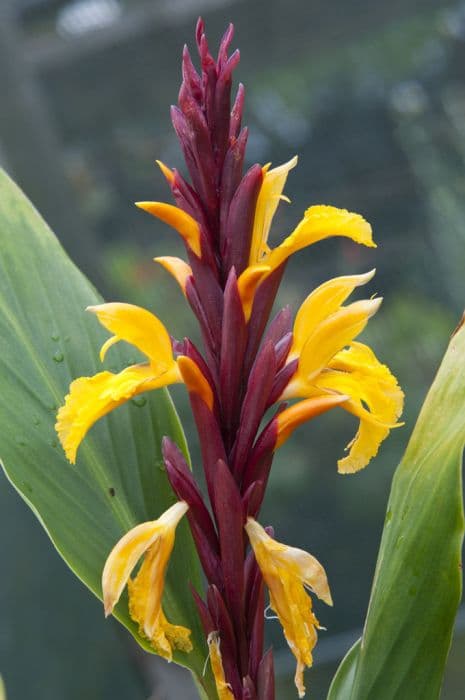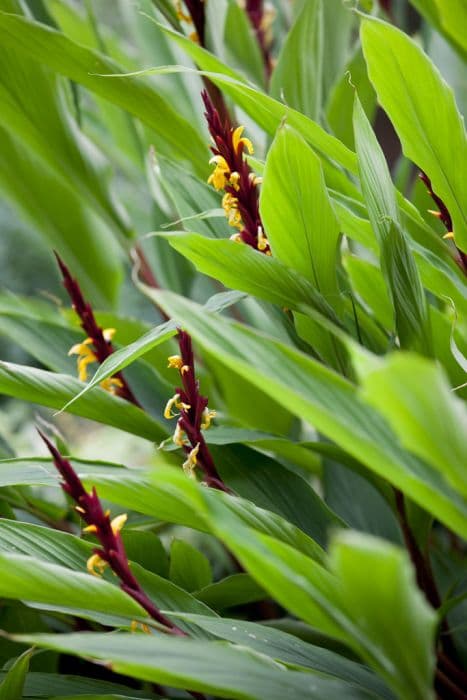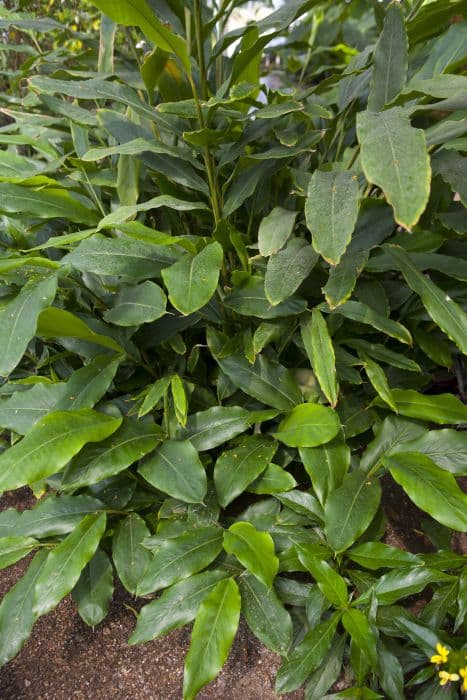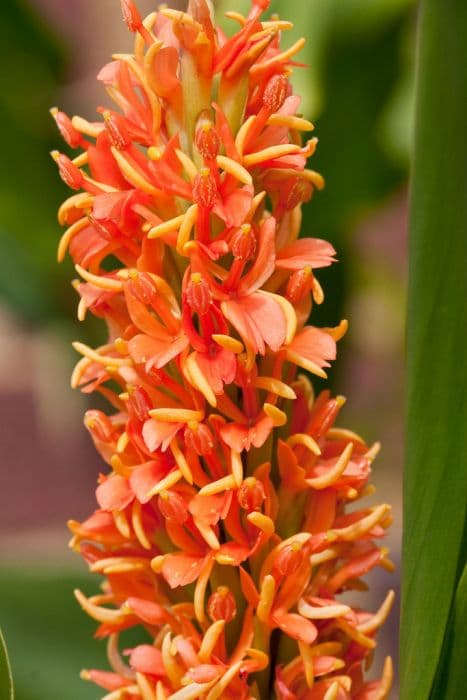Orange Ginger Lily Hedychium 'Tara'

ABOUT
Hedychium 'Tara', commonly known as the Orange Ginger Lily, is a striking perennial plant that is treasured for its vibrant floral display and lush foliage. The plant features long, lance-shaped leaves that are bright green in color, creating a dense and tropical clump. These leaves provide a lush backdrop for the truly remarkable flowers that this variety produces. The flowers of the Orange Ginger Lily are its most noted feature, presenting themselves in bold, fragrant clusters. Each bloom is a radiant orange color that can range from a soft, peachy hue to a fiery, almost electric orange, depending on the plant. These blossoms are typically arranged in conical or cylindrical spikes that rise above the foliage, creating a showy and exotic display that can bring a tropical feel to any garden setting. Each individual flower is shaped somewhat like a small butterfly, with the petals spreading out from the central part of the flower, providing a delicate and intricate appearance. The petals are known for their waxy texture and may have a slight sheen to them, catching the light and drawing the eye. The stamens protrude from the center of the flower, often adding a contrasting highlight to the flower's core. The Orange Ginger Lily also has a delightful fragrance, which is especially potent in the evenings or early morning. The scent is sweet and inviting, contributing to the overall sensory appeal of the plant. This delightful aroma, coupled with the plant's visual impact, makes Hedychium 'Tara' a popular choice for ornamental gardens where it can be enjoyed up close, such as in flower beds, borders, or as a specimen planting. Please note that when cultivating the Orange Ginger Lily, other aspects including growing requirements and size should be taken into consideration. However, this detailed description focuses solely on the visual and olfactory characteristics of this magnificent plant without mentioning its specific dimensions.
About this plant
 Names
NamesFamily
Zingiberaceae.
Synonyms
Tara Ginger Lily, Tara Ginger, Tara Garland Flower, Orange Bottlebrush Ginger.
Common names
Hedychium 'Tara'.
 Toxicity
ToxicityTo humans
Tara ginger is not widely known to be toxic to humans. However, as with many plants, some people may experience mild allergic reactions or stomach upset if any part of the plant is ingested. It is always wise to avoid eating plants that are not specifically grown for consumption.
To pets
Tara ginger is not widely recognized as a toxic plant to pets. Nevertheless, ingestion of non-food plants can sometimes lead to gastrointestinal discomfort, such as vomiting or diarrhea, in pets like cats and dogs. If your pet ingests this plant and shows adverse symptoms, it would be best to consult a veterinarian.
 Characteristics
CharacteristicsLife cycle
Perennials
Foliage type
Deciduous
Color of leaves
Green
Flower color
Orange
Height
6 feet (1.83 meters)
Spread
2 feet (0.61 meters)
Plant type
Herb
Hardiness zones
8
Native area
Himalayas
Benefits
 General Benefits
General Benefits- Ornamental Appeal: Hedychium 'Tara', commonly known as Orange Ginger Lily, offers striking ornamental value with its vibrant orange flowers and lush green foliage.
- Attracts Pollinators: The fragrant blossoms attract pollinators such as bees, butterflies, and hummingbirds, which can benefit the overall health of your garden.
- Ease of Care: Orange Ginger Lily is known for being low-maintenance, requiring minimal care once established, making it suitable for gardeners of all levels.
- Tropical Aesthetic: Adding this plant to a landscape provides a tropical look that can enhance the aesthetic of garden spaces and serve as a focal point.
- Fragrance: The sweet, strong perfume of Tara's flowers can fill a garden with pleasant aromas, especially during the evening.
- Cut Flowers: The blooms make excellent cut flowers for arrangements indoors, with a long vase life and attractive appearance.
- Rapid Growth: This plant is a fast grower, which means it can quickly fill in garden spaces or form sizeable clumps for a dramatic effect.
- Screening Plant: Due to its height and dense foliage, Tara can be used as a natural screen to provide privacy or to hide unsightly areas in the landscape.
 Medical Properties
Medical Properties- Antimicrobial: Hedychium 'Tara' may possess antibacterial and antifungal properties, which can help in inhibiting the growth of certain pathogens.
- Anti-inflammatory: Components within the plant could potentially reduce inflammation when applied to the skin or taken internally, though specific studies on Hedychium 'Tara' are lacking.
- Analgesic: There is potential for Hedychium species to offer pain relief, but evidence for Hedychium 'Tara' specifically is not well-documented.
- Antioxidant: As with many plants, Hedychium 'Tara' may contain antioxidant compounds, which can help to neutralize harmful free radicals in the body.
 Air-purifying Qualities
Air-purifying QualitiesThis plant is not specifically known for air purifying qualities.
 Other Uses
Other Uses- Hedychium 'Tara', commonly known as Tara ginger, can be used to create natural dyes for fabrics, offering hues ranging from soft yellows to vibrant oranges depending on the mordant used.
- The infusion of Tara ginger flowers can act as a gentle insect repellent when applied to skin or clothing, thanks to its distinctive aroma that insects tend to avoid.
- The robust stems of Tara ginger can be woven into baskets or mats, utilizing the plant's fibrous quality for crafting durable goods.
- The waxy, aromatic flowers of Tara ginger can be incorporated in potpourri mixes or used as natural air fresheners in small spaces.
- Tara ginger's flowers are sometimes used in the production of exotic-flavored honey when grown near apiaries, as bees are attracted to the flowers' rich nectar.
- Floral designers may use Tara ginger blossoms in tropical-themed flower arrangements due to their striking appearance and longevity when cut.
- Whole or crushed Tara ginger leaves can be added to bathwater for a fragrant, soothing bath experience, embracing aromatherapy benefits.
- The plant's large, decorative leaves can serve as a natural wrapping material for small parcels or food items, adding an eco-friendly touch.
- In some cultures, the flowers of Tara ginger are used in ceremonies or festivals as offerings or decorations, symbolizing diverse cultural values.
- The root of Tara ginger, while not commonly used, can be fermented to create unique flavors in homemade beer or spirits, exploring the plant's culinary possibilities.
Interesting Facts
 Feng Shui
Feng ShuiThe Tara Ginger is not used in Feng Shui practice.
 Zodiac Sign Compitability
Zodiac Sign CompitabilityThe Tara Ginger is not used in astrology practice.
 Plant Symbolism
Plant Symbolism- Exotic Beauty: Hedychium 'Tara', commonly known as the Orange Ginger Lily, possesses strikingly beautiful orange flowers which symbolize unique and striking beauty that stands out in any setting.
- Inviting Aroma: The Orange Ginger Lily is known for its sweet, inviting fragrance which symbolizes attraction and the ability to draw others in with charm and grace.
- Vibrancy: The vibrant orange hue of the flowers represents energy, enthusiasm, and a zest for life, reflecting an optimistic and positive outlook.
- Sensuality: The lush foliage and the sensual shape of the blossoms can represent sensuality and the pleasures of the senses, making the Orange Ginger Lily an emblem of desire and allure.
- Tropical Origin: Originating in tropical regions, this plant symbolizes luxuriance and a paradise-like state, often connected to abundance and richness in life.
 Water
WaterThe Tara ginger plant should be watered thoroughly, allowing the top inch of the soil to dry out between waterings to ensure that the roots do not sit in water, which could lead to root rot. In active growth periods, typically during the warmer months, water about once a week with approximately half a gallon for a medium-sized pot. During the dormant period, in cooler months, reduce watering frequency to every couple of weeks, using approximately a quarter of a gallon each time to accommodate the plant's reduced water needs.
 Light
LightTara ginger prefers a spot that receives partial shade with bright, indirect sunlight for optimal growth. Direct afternoon sunlight can be too intense and may scorch the leaves, so dappled sunlight or a location that provides some shelter from the harsh sun is ideal. A north or east-facing window indoors, or a shaded area in a garden that gets morning sun and afternoon shade, would suit this plant well.
 Temperature
TemperatureTara ginger thrives in temperatures between 60°F and 85°F, making it suitable for growing in a wide range of climates. However, it is not frost-hardy and should be protected or brought indoors when temperatures dip below 50°F. Maximum cold tolerance is around 40°F, but even at this low temperature, the plant may suffer damage. Ideal conditions are warm and humid, mimicking its natural tropical habitat.
 Pruning
PruningPruning Tara ginger is important for maintaining its shape and encouraging lush growth. Prune in the spring, as new growth begins, by removing any dead or damaged stalks and spent flower heads to promote new flower production. Cut back old growth to within a few inches above the ground if necessary. Pruning can be done annually or as needed to keep the plant looking tidy and to encourage healthy, vigorous growth.
 Cleaning
CleaningAs needed
 Soil
SoilTara Ginger requires well-draining, fertile soil rich in organic matter. The ideal soil pH is slightly acidic to neutral, ranging from 6.0 to 7.5. A good soil mix could be equal parts of loam, peat, and perlite to ensure proper drainage and aeration.
 Repotting
RepottingTara Ginger should be repotted every 2 to 3 years, or once the rhizomes fill the pot. It is best to repot during spring or early summer when the plant is entering its active growth phase.
 Humidity & Misting
Humidity & MistingTara Ginger thrives in high humidity conditions, ideally between 60-80%. High ambient moisture is crucial for the plant's healthy growth, and it benefits from regular misting if the air is too dry.
 Suitable locations
Suitable locationsIndoor
Place Tara Ginger in a bright, indirect light area with high humidity.
Outdoor
Plant Tara Ginger in partial shade, sheltered from wind, with moist soil.
Hardiness zone
7-10 USDA
 Life cycle
Life cycleThe life of the Hedychium 'Tara', commonly known as Orange Ginger Lily, begins with the germination of its rhizome, which requires warm and humid conditions. Once the rhizome sprouts, the plant enters a period of vegetative growth, producing tall, slender stems and long, green leaves, as well as forming a robust root system. During the flowering stage, the ginger lily produces striking orange flowers in large clusters, which are often fragrant and attract a variety of pollinators. After pollination, the flowers develop into seed capsules containing numerous seeds, which can be dispersed by wind or animals, leading to the growth of new plants when conditions are favorable. Throughout the growing season, the rhizomes continue to expand, potentially producing additional shoots that will give rise to new flowering stems. As a perennial, the ginger lily dies back to the ground during colder months and enters dormancy, only to re-emerge and repeat its growth cycle with the return of warm, moist conditions in spring.
 Propogation
PropogationPropogation time
Spring-Early Summer
The most popular method of propagation for the Ginger Lily 'Tara' is by dividing the rhizomes. This should be done in the late winter or early spring before the plant begins its active growth. To propagate, carefully dig up the clump of the ginger lily and use a sharp knife or spade to cut the rhizomes into sections, ensuring that each section has at least one growth bud. These sections can then be replanted about an inch (2.54 centimeters) deep in a well-draining soil with some added organic matter. It's important to water the new plantings gently but thoroughly to settle the soil around the rhizomes and encourage root development. With proper care, these divisions should develop into healthy, blooming plants within a season or two.









